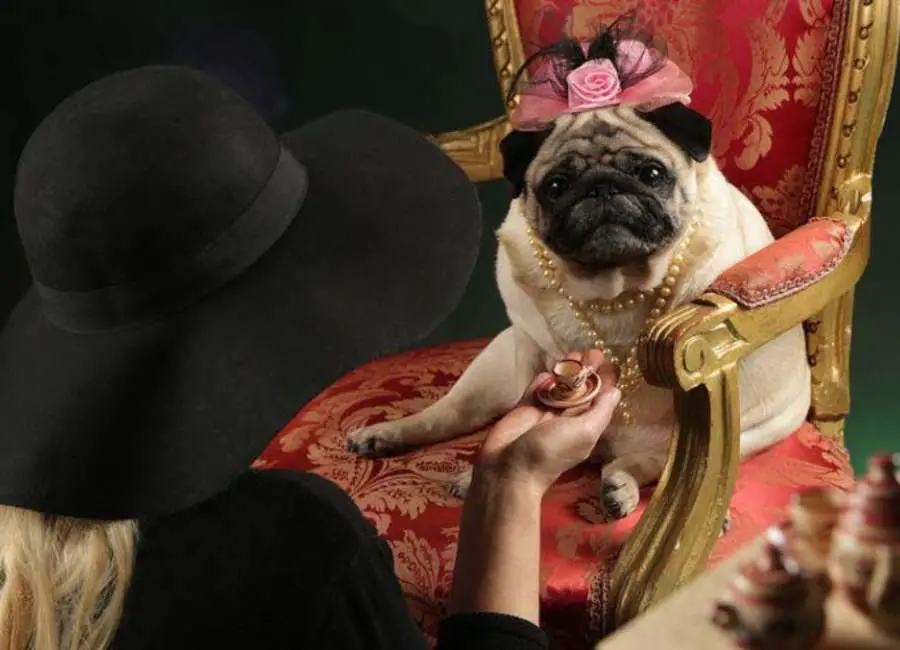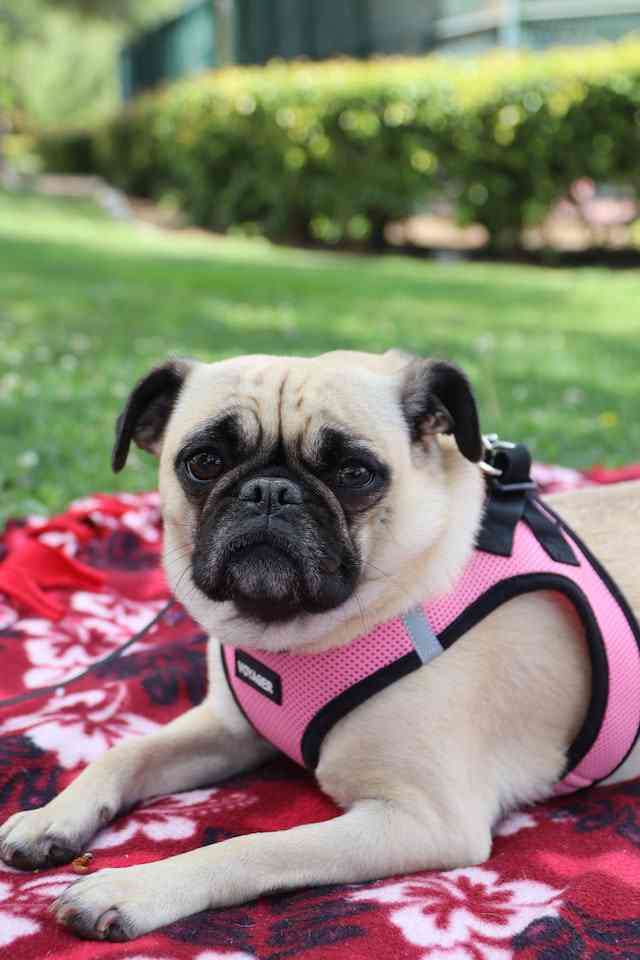20 Pug Pros And Cons You Should Know

Let’s discuss some common Pug pros and cons you should know before getting one!
Thinking about bringing the adorable and squishy-faced pug into your home? Well, you’re in the right place! In this blog post, we’re going to dive into the pros and cons of having a pug as your furry companion.
From their lovable personalities and endless cuddles to their stubborn streak and potential health issues, we’ll cover it all! Let’s get started!
Pug Pros And Cons
Pug Pros: Pugs are affectionate, charming, and have a playful personality and temperaments, making them great companions. They have a small size, making them suitable for apartment living. Pugs are generally good for children and other pets.
Pug Cons: Pugs are prone to various health issues due to their brachycephalic (short-nosed) face, which can lead to breathing difficulties and other respiratory problems. They shed a lot, requiring regular grooming to manage their fur. Pugs may be stubborn during training, requiring patience and consistent positive reinforcement.
Let’s delve deeper for a better understanding…
Pros of Owning a Pug

The following are some of the most common pros of owning a Pug:
1. Loving and Affectionate
Pugs are masters of cuddles and affection. Their desire for human contact is insatiable, and they thrive on being close to their owners.
When you sit down to relax, don’t be surprised if your Pug immediately hops onto your lap, seeking warmth and comfort.
They’ll gladly nuzzle up to you, showering you with kisses and love. The bond you’ll form with your Pug is genuinely heartwarming and deeply rewarding.
2. Perfect for Apartments
Pugs are a dream come true for city dwellers and those living in smaller spaces. Unlike some larger breeds, Pugs don’t require a huge backyard or sprawling living quarters to be happy.
They adapt well to apartment living, making them an ideal choice for urban environments. Just be sure to take them for regular walks and provide indoor play opportunities to keep them mentally and physically stimulated.
3. Family-Friendly
Pugs are fantastic family pets. Their gentle and patient nature makes them excellent companions for children of all ages.
They’ll happily tolerate the exuberance of kids, and their affectionate disposition ensures that they’ll become fast friends with everyone in the household.
Pugs are known to form strong bonds with each family member, creating a loving and harmonious atmosphere at home.
4. Sociable Butterflies
Pugs are social butterflies that relish being in the company of both humans and other pets. They have a knack for winning hearts wherever they go, and they thrive in social settings.
Whether it’s a playdate at the dog park or a friendly gathering with friends, your Pug will be the star of the show, bringing smiles to everyone’s faces.
5. Low Maintenance Grooming
If you’re not a fan of extensive grooming sessions, a Pug is a perfect match for you. Their short, sleek coat requires minimal maintenance.
Regular brushing helps keep their fur clean and reduces shedding. Additionally, Pugs don’t have a strong doggy odor, which is an added bonus for those sensitive to smells.
6. Loyal to the Core
Pugs are fiercely loyal and devoted to their owners. Once they form a bond with you, they’ll become your most loyal confidant and companion. They’ll follow you around the house, sit at your feet, and look up at you with adoring eyes.
Pugs are known for their unwavering dedication, and they’ll stand by your side through thick and thin, offering comfort and support whenever you need it.
7. Adaptable Exercise Routine
While Pugs enjoy a good romp and play session, they aren’t high-energy dogs that demand constant physical activity. Their moderate exercise needs make them a great fit for various lifestyles.
Whether you’re an avid outdoor enthusiast or prefer a more laid-back lifestyle, your Pug will happily adjust to your pace and be content with your companionship.
8. Emotional Support Experts
Pugs have an incredible ability to sense their owner’s emotions. When you’re feeling down or stressed, your Pug will be there to provide comfort and solace.
Their nurturing and empathetic nature makes them excellent emotional support animals. Many Pug owners have attested to the calming effect their Pugs have during difficult times, making them a treasured source of emotional well-being.
9. Longevity of Love
The bond you form with your Pug can last for many years. Pugs tend to live relatively long lives compared to some other dog breeds.
With proper care, a balanced diet, regular exercise, and regular veterinary check-ups, you can expect to enjoy your Pug’s delightful company for a good 12 to 15 years or even longer.
The enduring love and companionship they provide make every moment spent with them truly special.
10. Charm that Melts Hearts
Pugs are like living teddy bears. Their round, wrinkled faces and big, soulful eyes exude an irresistible charm. It’s as if they were specially designed to tug at our heartstrings.
Every time a Pug looks up at you with those puppy-dog eyes, you can’t help but feel a rush of affection. Their adorable appearance is one of the primary reasons why Pug owners fall head over heels for these little cuties.
11. Endless Playfulness
Pugs seem to possess a never-ending well of energy when it comes to playtime. They have a knack for finding joy in the simplest things, turning even the most mundane activities into entertaining games.
From chasing after a ball to playing tug-of-war with a favorite toy, a Pug’s playful spirit is infectious. Their bursts of enthusiasm and excitement can turn any ordinary day into a fun-filled adventure.
Learn more about pug facts.
Cons of Owning a Pug

The following are some of the most common cons of owning a Pug:
1. Brachycephalic Breathing Issues
Pugs have a unique facial structure with a short, flat nose and a pushed-in face. This adorable trait is called brachycephaly. While it gives them an endearing appearance, it also comes with respiratory challenges.
Pug-shortened airways can lead to difficulties in breathing, especially in hot or humid weather. Pugs may pant heavily, snort, and wheeze as they struggle to get enough air.
This makes them particularly vulnerable to heatstroke, so it’s essential to keep them cool during warmer months and avoid strenuous activities in the heat.
2. Prone to Health Issues
Pugs are lovable, but they do have their fair share of health problems. Obesity is common among Pugs due to their love for food, and overweight Pugs can experience additional health complications.
Regular exercise and a balanced diet are crucial to maintaining their health. Additionally, their skin folds can become breeding grounds for skin issues if not kept clean and dry.
Hip dysplasia, a genetic disorder affecting the hip joint, is also prevalent in Pugs, causing discomfort and mobility issues. Furthermore, Pugs can suffer from eye problems, such as corneal ulcers and dry eye, which require careful monitoring and appropriate treatment.
3. Stubborn Streak
Pugs are intelligent creatures, which can make training an enjoyable experience. However, their intelligence can sometimes lead to stubbornness.
They have a mind of their own and may choose to ignore commands or training cues if they’re not in the mood. Patience, consistency, and positive reinforcement are essential for successful training and to ensure they understand their boundaries.
4. Separation Anxiety
Pugs are highly affectionate and thrive on human companionship. When left alone for extended periods, pugs may experience separation anxiety. This can lead to behavioral issues such as excessive barking, destructive chewing, or even potty accidents.
Providing them with toys, puzzle games, or interactive treats can help keep them mentally stimulated and alleviate their anxiety during your absence.
5. Noise Sensitivity
For their small size, Pugs are quite vocal and alert dogs. They tend to bark at any unusual sound or activity, making them excellent watchdogs.
However, this may not be suitable for everyone, especially if you live in close quarters with neighbors who may not appreciate the constant barking. Training your Pug to respond to commands that control their barking can help address this issue.
6. High Maintenance Grooming
Pug owners quickly learn that their furry companions shed—a lot! Their short, double coat sheds year-round, with some heavier shedding during seasonal changes.
Daily brushing is recommended to minimize loose hair and keep their coat looking tidy. Without regular grooming, their loose hairs can accumulate on furniture, clothing, and floors, making it necessary to invest time in keeping their living environment clean.
7. Temperature Sensitivity
Pugs are highly sensitive to extreme temperatures due to their brachycephalic features. Hot weather can be particularly problematic, as they struggle to regulate their body temperature efficiently.
Heatstroke is a real concern for Pugs, so it’s crucial to avoid vigorous exercise in hot weather and provide them with a cool, shaded area. In colder climates, they may need extra layers to stay warm during chilly days.
8. Potty Training Challenges
Potty training a Pug can be a test of patience. They have a small bladder and may not be as quick to pick up on potty training cues as some other breeds.
Consistency in scheduling regular potty breaks, positive reinforcement, and crate training can help with the housebreaking process.
Read more: 9 Pug Behavior Concerns You Should Know.
9. Pugs do snore a lot while sleeping
Pugs have a reputation for being snoring dogs, and while this may be true for some pugs, it is not the case for all pugs. Snoring also has negative health effects on your dog’s breathing and heart rate.
This can lead to problems like sleep apnea, which causes snoring as well as other health issues such as high blood pressure and congested nasal passages.
If you notice your dog snoring too much or suddenly stops doing so after being on medication, talk with your veterinarian about what else could be causing this behavior change so they can treat it effectively.
Learn more about adopting a pug.
9. Pugs easily get overweight resulting in obesity
Pugs are cute, but they can be a little on the chubby side. If your pug is overweight, it’s important to address the problem right away by making sure they get plenty of exercise and dieting.
You should also consult with your veterinarian if you think your pup may have issues with his or her weight.
Read more: Best Tips On How To Care For Pugs.
Conclusion
Pugs are great pets, but they do have their pros and cons. They are affectionate, easy to take care of and make good companions.
If you’re looking for an exotic pet that won’t require much exercise or maintenance, then a pug may be the right choice.
I hope this post answered your question about pug pros and cons.
